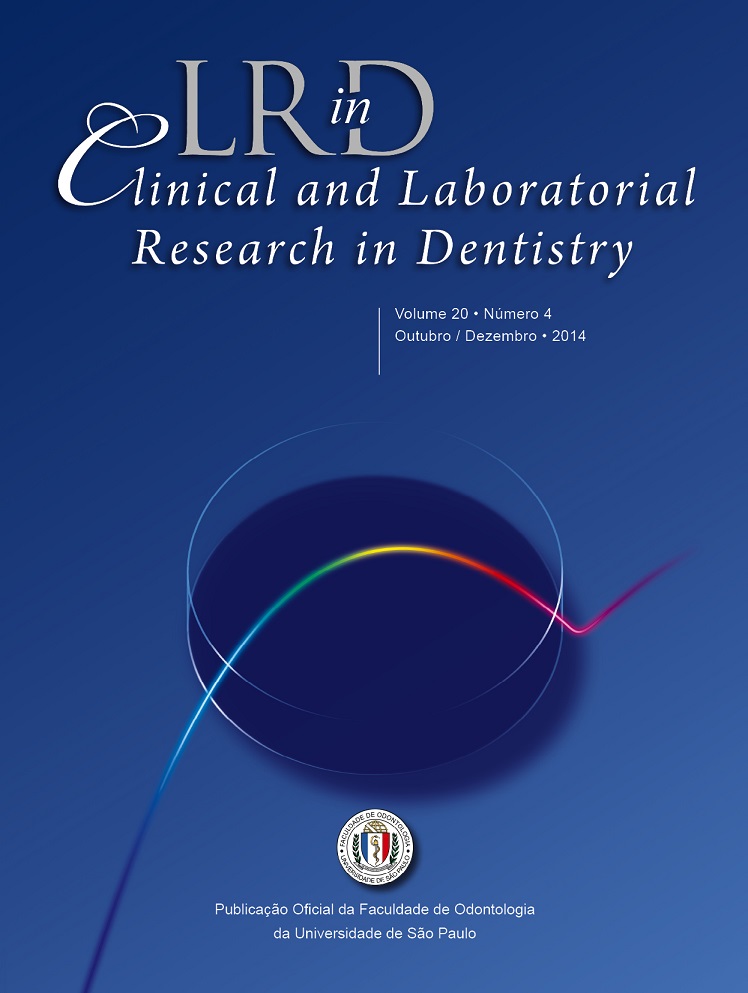Avaliação por ressonância magnética da alteração dimensional do músculo pterigóideo e da posição do disco articular no movimento mandibular
DOI:
https://doi.org/10.11606/issn.2357-8041.clrd.2014.82373Palavras-chave:
Imagem por Ressonância Magnética, Articulação Temporomandibular, Músculos Pterigoides.Resumo
O músculo pterigóideo lateral (MPL) tem sido o foco de inúmeros estudos que tentam elucidar o seu possível papel na disfunção temporomandibular, condição na qual o deslocamento do disco é amplamente aceito como um possível aspecto clínico. No entanto, poucos estudos investigaram a associação entre a posição do disco e alterações morfológicas do MPL. Objetivos: investigar a relação entre a posição do disco articular e a área da porção superior e da porção inferior da músculo pterigóideo lateral usando ressonância magnética. Métodos: A amostra foi composta por 148 articulações temporomandibulares de 74 pacientes com queixa de dor e/ou disfunção articular. Imagens em plano sagital foram utilizadas para a avaliação da posição do disco e para traçados. Traçados das áreas do músculo foram realizados em 4 posições mandibulares (em repouso, e em aberturas de 10 mm, 20 mm e 30 mm) com a ajuda de software de processamento de imagem. Os dados adquiridos foram submetidos à análise estatística. Resultados: Os testes estatísticos revelaram mudanças nas áreas superior e inferior do músculo pterigóideo lateral durante o movimento de abertura mandibular, mostrando uma redução na área total e mudanças mais heterogêneos na área superior. Relevância: Observou-se que a área média da porção inferior muscular estava reduzida nas posições avaliadas e não mostrou correlação com deslocamento de disco. Para a porção superior, a redução da área média foi associada com o deslocamento anterior do disco sem redução, ao passo que o aumento da área média foi correlacionado com o deslocamento anterior do disco com redução.Downloads
Referências
References
Carpentier P, Yung JP, Marguelles-Bonnet R, Meunissier M. Insertions of lateral pterygoid muscle: an anatomic study of human temporomandibular joint. J Oral Maxillofac Surg. 1988 Jun;46(6):477-82.
Dergin G, Kilic C, Gozneli R, Yildirim D, Garip H, Moroglu S. Evaluating the correlation between the lateral pterygoid muscle attachment type and internal derangement of the temporomandibular joint with an emphasis on MR imaging findings. J Craniomaxillofac Surg. 2012 Jul;40(5):459-63.
D'Ippolito SM, Borri Wolosker AM, D'Ippolito G, Herbert de Souza B, Fenyo-Pereira M. Evaluation of the lateral pterygoid muscle using magnetic resonance imaging. Dentomaxillofac Radiol. 2010 Dec;39(8):494-500.
Goto TK, Tokumori K, Nakamura Y, Yahagi M, Yuasa K, Okamura K et al. Volume changes in human masticatory muscles between jaw closing and opening. J Dent Res. 2002 Jun;81(6):428-322
Hiraba K, Hibino K, Hiranuma K, Negoro T. EMG activities of two heads of the human lateral pterygoid muscle in relation to mandibular condylar movement and biting force. J Neurophysiol. 2000 Apr;83(4):2120-37.
Juniper RP. Temporomandibular joint dysfunction: a theory based upon electromyographic studies of the lateral pterygoid muscle. Br J Oral Maxillofac Surg 1984 Feb;22(1):1-8.
Katzberg RW, Schenck J, Roberts D, Tallents RH, Manzione JV, Hart HR et al. Magnetic resonance imaging of the temporomandibular joint meniscus. Oral Surg Oral Med Oral Pathol 1985 Apr;59(4):332-5.
Liu ZJ, Yamagata K, Kuroe K, Suenaga S, Noikura T, Ito G. Morphological and positional assessments of TMJ components and lateral pterygoid muscle in relation to symptoms and occlusion of patients with temporomandibular disorders. J Oral Rehabil 2000 Oct;27(10):860-74.
Murray GM, Phanachet I, Uchida S, Whittle T: The human lateral pterygoid muscle: a review of some experimental aspects and possible clinical relevance. Aust Dent J. 2004 Mar;49(1):2-8.
Naidoo LC. Lateral pterygoid muscle and its relationship to the meniscus of the temporomandibular joint. Oral Surg Oral Med Oral Pathol Oral Radiol Endod. 1996 Jul;82(1):4-9.
Omami G, Lurie A. Magnetic resonance imaging evaluation of discal attachment of superior head of lateral pterygoid muscle in individuals with symptomatic temporomandibular joint. Oral Surg Oral Med Oral Pathol Oral Radiol. 2012 Nov;114(5):650-7.
Wilkinson TM. The relationship between the disc and the lateral pterigoid muscle in the human temporomandibular joint. J Prosthet Dent. 1988;60(6):715-24.
Wilkinson T, Chan EK. The anatomic relationship of the insertion of the superior lateral pterygoid muscle to the articular disc in the temporomandibular joint of human cadavers. Aust Dent J. 1989 Aug;34(4):315-22.
Downloads
Publicado
Edição
Seção
Licença
Solicita-se aos autores enviar, junto com a carta aos Editores, um termo de responsabilidade. Dessa forma, os trabalhos submetidos à apreciação para publicação deverão ser acompanhados de documento de transferência de direitos autorais, contendo a assinatura de cada um dos autores, cujo modelo está a seguir apresentado:
Eu/Nós, _________________________, autor(es) do trabalho intitulado _______________, submetido agora à apreciação da Clinical and Laboratorial Research in Dentistry, concordo(amos) que os autores retém o direitos autorais e garantem a revista o direito da primeira publicação, sendo o trabalho simultaneamente autorizado sob a Creative Commons Attribution License, que permite a outros compartilhar o artigo com reconhecimento da autoria do trabalho e publicação inicial nesta Revista. Aos autores será possibilitada a distribuição em separado da versão publicada do artigo, arranjos contratuais adicionais para a distribuição não-exclusiva da versão publicada (por exemplo, publicá-la em um repositório institucional ou publicação em livro), com o reconhecimento de sua publicação inicial nesta revista. Aos autores será permitido e encorajado publicar seu trabalho on-line (por exemplo, em repositórios institucionais ou em seu site) antes e durante o processo de envio, pois pode levar a intercâmbios produtivos, bem como a maior citação do trabalho publicado. (Veja The Effect of Open Access).
Data: ____/____/____Assinatura(s): _______________


